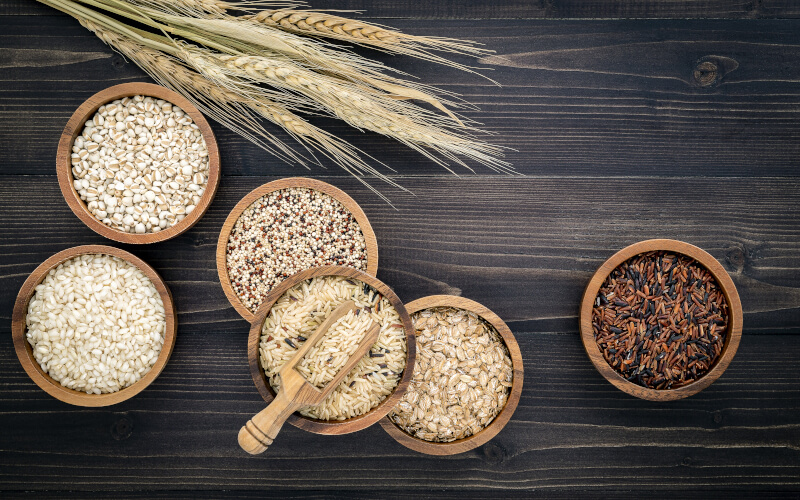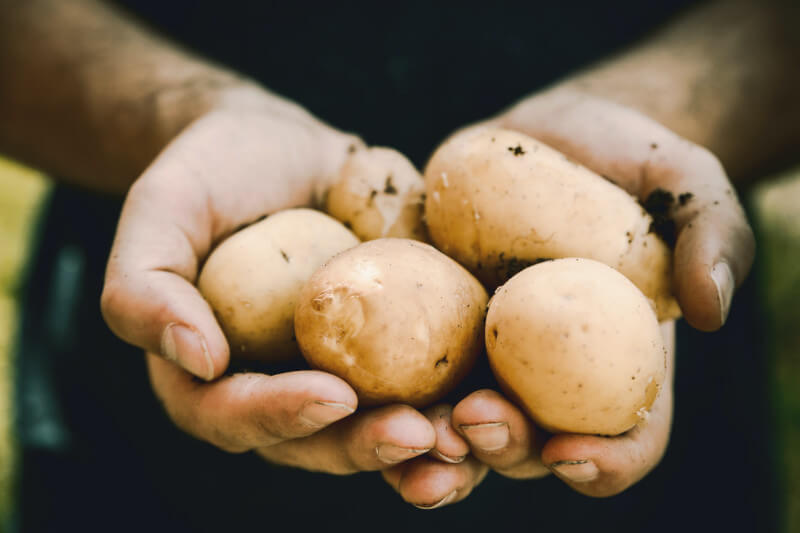When one thinks of vodka, the mind often drifts to the crystalline clarity of the liquid and the sharp bite on the palate. What many may not know is the rich variety of ingredients that can be utilized in its production. From fruits to honey and even quinoa, vodka displays versatility in its core. Yet, two primary contenders have long stood out in the vodka realm: potatoes and grain. We’re here to look at how they shape the spirit, and which might reign supreme for different palates and purposes.
Understanding The Ingredients
Potatoes, often associated with the stereotypical vodka image, surprisingly, don’t play as significant a role in modern vodka production as one might think. The common perception is rooted in historical practices where pot distillation dominated. In contemporary times, however, grains, particularly cereal grains such as wheat, rye, barley, corn, and sorghum, have taken the lead.
Grain-Based Vodka Brands

Absolut
- Origin: Established in Åhus, Sweden in 1879 by Lars Olsson Smith.
- Base Ingredient: Primarily uses winter wheat sourced locally from around 450 farmers in the vicinity of the distillery.
- Production: Employs a continuous distillation process, a method pioneered by the founder, which ensures a consistent quality of vodka.
- Product Range: Offers a wide array of products including its classic vodka and a range of flavored vodkas, which incorporate natural ingredients.
Grey Goose
- Origin: Created in the Cognac region, France in the 1990s by Sidney Frank and François Thibault, a well-known cognac producer.
- Base Ingredient: Made from single-origin Picardie wheat and water from the natural limestone-filtered spring in Gensac-la-Pallue.
- Production: Utilizes a batch distillation process in copper pot stills to preserve the qualities of its high-grade wheat.
Ketel One
- Origin: Founded in Schiedam, Netherlands in 1691 by Joannes Nolet, represents one of the oldest family-run distilleries globally.
- Base Ingredient: Crafted using high-quality non-GMO European wheat.
- Production: A meticulous production process that integrates modern column distillation with traditional pot distillation, leveraging the benefits of both techniques.
Potato-Based Vodka Brands

Woody Creek
- Origin: Situated in the Roaring Fork Valley of Colorado, this relatively young distillery has quickly established a reputation for premium spirits.
- Base Ingredient: Primarily utilizes Colorado-grown Rio Grande potatoes, maintaining a farm-to-bottle approach to ensure quality.
- Product Range: While noted for its signature potato vodka, it also produces gin and rye whiskeys, each bearing a mark of quality craftsmanship.
Chopin Potato Vodka
- Origin: A Polish brand established in 1993, named after the renowned composer Frédéric Chopin.
- Base Ingredient: Produced using Polish potatoes, showcasing the very essence of the ingredient’s characteristics in the final product.
- Production: The vodka undergoes a distillation process four times, ensuring a product of high purity and smoothness.
- Product Range: Apart from the premium potato vodka, Chopin also offers rye and wheat-based vodkas, providing a rich diversity in flavor profiles.
Production Process with Both Ingredients
Vodka production, regardless of the base ingredient, generally follows a tried-and-true three-step process: fermentation, distillation, and filtration. The first step involves mashing, where grains or potatoes are combined with water and yeast, fostering an environment conducive to ethanol production. Post-fermentation, the concoction is distilled to remove impurities, ensuring the vodka’s iconic clear appearance and taste. Some brands, like Grey Goose, adhere to a single distillation due to the premium quality of their ingredients, while others may distill multiple times. Filtration is the final stage where remaining impurities are further purged using mediums like charcoal or quartz crystals.
Despite these similarities in production, the initial ingredient undoubtedly influences the vodka’s character. Let’s assess the unique qualities imparted by potatoes and grain.
The Depth and Distinctiveness of Potato Vodka
Widely regarded as the more flavorful variant, potato vodka offers a full-bodied profile. Its robust nature makes it a favorite for those who prefer their vodka straight, allowing them to appreciate the intricate flavors and aromas. But why does potato vodka have this characteristic depth? It’s all about the starches. Potatoes have a different starch structure than grains, leading to a different fermentation process and, consequently, a distinctive taste.
Versatility and Neutrality of Grain Vodka
Grain vodkas, on the other hand, tend to possess a flatter flavor profile. This neutrality is often seen as an advantage when it comes to cocktail concoctions. Without a potent base flavor, grain vodka allows other ingredients in a mix to shine, creating a harmonious blend. It’s no surprise that many bartenders and mixologists favor grain vodka for its adaptability.
Gluten Concerns and Misconceptions
A common misconception revolves around the gluten content in vodkas. One might intuitively think that potato vodka is the go-to choice for those with gluten restrictions. However, even grain vodkas distilled from wheat, barley, or rye can be deemed gluten-free. The distillation process effectively removes gluten molecules, rendering most vodkas suitable for those with gluten sensitivities. It’s essential, however, to note that certain brands might reintroduce gluten post-distillation, so always check labels if gluten is a concern. The gluten misconception is not the only one, there are a few other misunderstandings that circulate in the discourse about potato and grain vodkas which we would like to clear up for you:
Caloric Content Differences are Significant
Reality: A prevalent belief stands that there is a wide gap in the caloric contents of potato and grain vodka, with the former often thought to be higher in calories. In truth, both variants exhibit a similar caloric range — around 97 calories per 1.5-ounce serving, debunking the theory of a substantial difference in caloric content. Thus, choosing a vodka variant based on caloric content does not find a basis in reality, allowing for a wider range of choices based on personal preference rather than mistaken nutritional values.
Potato Vodka is Inferior to Grain Vodka
The Truth: The notion that potato vodka is of lower quality compared to grain vodka persists, a perception possibly grounded in historic economic factors and accessibility. Modern practices, however, defy this notion robustly. Brands such as Chopin and Woody Creek are carving out a space where potato vodka is viewed as a premium product, showcasing a rich flavor profile that doesn’t just match but often exceeds the quality standards set by grain vodkas.
More Distillations Equate to Better Quality
What’s Going on A well-entrenched belief in the vodka industry is that increased distillations result in a superior product. The theory posits that each subsequent distillation stage purifies the vodka more, enhancing its smoothness. Nonetheless, expert producers understand that a balance must be struck. For instance, Grey Goose relies on a single distillation process, leveraging premium French ingredients and spring water to maintain a rich flavor profile, indicating that the quality of vodka is not always dictated by the number of distillations but by a balanced production approach that respects the innate qualities of the initial ingredients.
Caloric Considerations
For the health-conscious, it’s good news all around. Potato vodka and its grain counterparts are nearly identical in caloric content. Both variants pack roughly 97 calories per 1.5 ounces, with no carbs.
Historical Precedence
Historically, fermented cereal grains held the limelight in vodka production. It was only in more recent times that potatoes took the stage. This shift, however, hasn’t hampered grain vodka’s popularity. Its market presence and versatility ensure its continued dominance in distilleries worldwide. Yet, the unique flavor profile of potato vodka ensures it retains a loyal fan base.
As with many things in the culinary and beverage world, preference plays a significant role. Those seeking depth, complexity, and a pronounced flavor might gravitate toward potato vodka. Meanwhile, those aiming for adaptability and a neutral base suitable for diverse mixers might find grain vodka more to their liking.
But this evaluation shouldn’t end on the note of which is “better.” Both potato and grain vodkas have their merits, and their differences make the vodka world richer and more varied. Whether you’re a bartender, a casual drinker, or someone just delving into the wide world of spirits, understanding the distinctions between potato and grain vodka equips you to make informed decisions tailored to your tastes and needs. After all, in the vast landscape of vodka, there’s plenty of room for both to shine.

